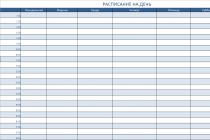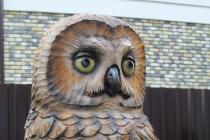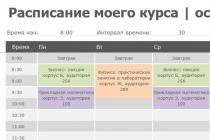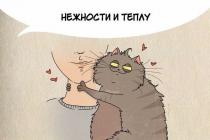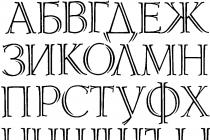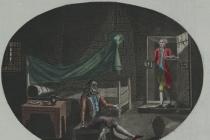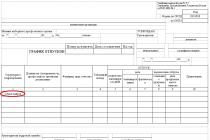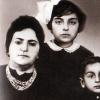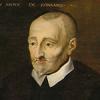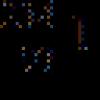Our life is full of events, many of which are real holidays. And on such days you want something special, this also applies to the design of the celebration itself. And some designs are directly related to writing beautiful texts that attract attention. In this regard, today we want to show you how original you can make holiday inscriptions using beautiful letters in Russian, and also how you can design the inscription so that it stands out. This and much more is below in the article.
The main thing in the article
Beautiful Russian letters for designing posters: templates with photos for cutting and printing
Posters reflect the essence of the event; most of them depict some symbolic things, names, inscriptions. If the poster is made in a bright style, then it will definitely attract the eye and interest. It is important not only to create a poster with colorful pictures and high-quality images, but also to make inscriptions to suit a specific style. Here are some examples that you can save, print and cut out.







Beautiful capital letters of the Russian alphabet for cutting: templates
Capital letters can set the tone for the beginning of a sentence. They should be big and beautiful. With the help of such techniques, a person’s attention is attracted, since the beginning of the text immediately intrigues.
If you want to use for your text uppercase capital letters, you will find the file for downloading them in one archive below.
Beautiful printed letters of the Russian alphabet for design: templates
You can use block letters to design comic posters or those written in an informative style.
- You can make all the printed letters yourself using large sheets of paper and a pencil.
- If it doesn’t work out the first time, you can always correct it and erase the excess.
- You can also use stencils, which you just need to trace, decorate, and your inscriptions will be ready.
- If you are good at redrawing, you can use our examples below.

Capital letters of the Russian alphabet in a beautiful font: templates for cutting and printing
Capital letters are more delicate and airy. It's easy to write a love message, a beautiful congratulation or a note for a loved one in cursive.
Beautiful Russian letters for nicknames: samples
Most people have a nickname, that is, a pseudonym under which they are recorded on social networks or other structures. A nickname often reflects what its wearer is like. And handwriting will give your nickname character, make it voluminous, characteristic of you.
Beautiful Russian letters for tattoos: photos
Recently, tattoos have been gaining wild popularity, especially text ones. A tattoo is a reflection of a person’s soul, expresses something that cannot be expressed in words, which in general is not necessary. Some people write the name of the one they love, others write down their values and priorities. And the more beautiful it is written, the more it attracts attention. Capital letters are best suited for tattoos—light, airy letters with “squiggles.”
Beautiful Russian graffiti letters: stencils
Graffiti is another type of painting that is typical for the design of streets and buildings. Inscriptions of this kind existed long before the appearance of those that are present on the local streets. Street painting often reflects the artist’s view of a particular position. There are a lot of fonts for this style, since each avant-garde artist sees the situation in his own way and uses his own unique handwriting.

Beautiful letters of the Russian alphabet with curls: samples
Letters with various kinds of curls look interesting and unusual; they can be used in writing magical and fairy-tale texts. Or any others you want to apply them to.



Beautiful letters of the Russian alphabet with monograms: pictures
Who doesn't love monograms? There are probably very few of them. Monograms are used everywhere: in the interior, in decoration, in paintings, in design, and even in text design.



Beautiful curly letters of the Russian alphabet: pictures
Curly letters, just like other letters, can be used to design interesting texts. They come in different types and sizes. And the design of the illustrations will help set the tone for your idea.

Beautiful carved letters of the Russian alphabet: pictures
Carved letters will look best in the “composition” of fairy-tale, magical texts, especially if you do them on thick paper and quite large.


Beautiful letters of the Russian alphabet in A4 format: print and cut out
Here you can view the letters in large format, as well as download and print.


















New Year's letters of the Russian alphabet
New Year - why not create a winter-themed poster? The letters below are suitable for design.

Calligraphic letters of the Russian alphabet: photo
Some people cannot boast of calligraphic handwriting, so a stencil or printed version of the text comes to their aid. Below are the calligraphic type alphabet options.

Beautiful letters of the Russian alphabet for children: pictures



Video: Three-dimensional beautiful letters of the Russian alphabet
The Russian alphabet is large and rich, it has 33 letters, each of which is beautiful in its own way. Therefore, before using foreign words, pay attention to how beautiful Russian letters are. With their help, you can design thousands of posters, and none of those written in a foreign language can compare with them.
You are in the Paper Letters coloring page category. The coloring book you are considering is described by our visitors as follows: "" Here you will find many coloring pages online. You can download Paper Letters coloring pages and print them for free. As you know, creative activities play a huge role in the development of a child. They activate mental activity, form aesthetic taste and instill a love of art. The process of coloring pictures on the theme of Paper Letters develops fine motor skills, perseverance and accuracy, helps you learn more about the world around you, and introduces you to all the variety of colors and shades. Every day we add new free coloring pages for boys and girls to our website, which you can color online or download and print. A convenient catalog, compiled by category, will make it easier to find the desired picture, and a large selection of coloring books will allow you to find a new interesting topic for coloring every day.The Russian language is one of the most vibrant, interesting and rich languages in the world. Millions of the best works are written on it - stories, fairy tales, poems. The language is rich and will not be repeated. Like everything fundamental, the Russian language has its own basis - the alphabet.
The birth of the Russian alphabet
Work on the creation of the alphabet began in 860 by order of the ruler of Byzantium, Michael III. He commissioned two brothers from the Greek city of Thessaloniki: Cyril and Methodius, to form a written Slavic language. Later, the Cyrillic alphabet was formed from the Greek version of the alphabet by Bulgarian monks.
The formation of the Russian alphabet is directly related to the adoption of Christianity in Europe. Slavic writing began to spread from Bulgaria after Tsar Boris adopted Christianity in 860. It was in Bulgaria that the first written Slavic school was founded. In it, ancient writings - chronicles - were translated into Slavic. Further, the Old Church Slavonic language appeared in Serbia and Kievan Rus. It was the fact that Old Church Slavonic became the recognized language of the official Russian Church that influenced the fact that over time it replaced Old Russian. At the same time, it retained stable expressions and the folk tone of the speech of the Slavs.
Transformations of the Old Church Slavonic alphabet
Since the Russian alphabet was based on the Bulgarian Cyrillic alphabet, which spread after the Christianization of Rus', it initially had 43 letters.
Over time, 14 letters were deleted and 4 letters were added. This is due to the transformation of speech - sounds indicating unused letters have disappeared from it. First of all, the following were missing: iotized usas, large usas.
Under Patriarch His Holiness Nikon in the second half of the seventeenth century, a widespread census of books took place. This period is considered the time of reforms of Russian spelling. The serial numbers of the letters were recorded. But even at that time the alphabet was different from the modern one. Later, already under the reign of Peter I, superscript characters and some duplicate letters denoting numbers were excluded. At that time, Arabic numerals had already been introduced and the extra characters became irrelevant.
Back in 1917, the Russian alphabet had 35 letters. But as a result of the writing reform carried out in 1918, 33 letters remained in the Russian alphabet.
Structure of the Russian alphabet
Each word consists of minimal parts - sounds. They, like atoms in molecules, form the shell of the word. Each word and its form has a different sound design. What matters is the combination of letters in a word and the placement of stress.
In order to correctly distinguish the sound of a letter in a particular word, transcription is used. Transcription is a generally accepted graphical form that displays the sound of a word. Transcription shows:
- Syllables in a word.
- Which syllable is stressed in the word? Stress is indicated when a word consists of two or more syllables.
- Softness of consonants.
The letters of the alphabet are divided into several groups. The largest division of sounds is into vowels and consonants.
There are only six letters that are stressed vowels. When pronounced, the sound does not encounter any obstacles when passing through the oral cavity. When playing sounds, the ligaments of the larynx work - if you put your hand to your throat, you can feel the movement of the ligaments. If a person can freely shout or sing a letter, most likely it is a vowel sound. It is vowels that are the basis of syllables. The stressed syllable sounds most distinctly in a word. Unstressed syllables may be pronounced differently. That is why when writing words it is necessary to select test words.
When pronouncing consonants, sounds encounter an obstacle in their path. It is the presence of noise that distinguishes consonants and vowels. It is difficult to pronounce words with many consonants. That is why there are no words consisting only of consonants.
Consonants are divided into voiced and voiceless. There are unpaired and paired sounds.
Learning the Russian language begins with the alphabet. Understanding basic phonics and grammar is a key part of children's learning. By instilling in his child a love for his native language from infancy, a person pays tribute to history and traditions. Russian language is the richest language in the world. It is very important not to lose this wealth! Letters of the English alphabet can be downloaded.
Download beautiful letters of the Russian alphabet for printing in A4 format
 |
|
 |
|
 |
|
Before starting to learn the Russian language, any student must know its basis - the alphabet. You need to learn it in the very first lesson and you need to master this knowledge properly.

Any word in the Russian language consists of sounds, which are the basis of the shell of any word. Each word consists of a different sound design. The combination of letters in a word, as well as the stress, is of great importance.
In any language, including Russian, transcription is used to distinguish letters in words. It is transcription that helps to understand how a word sounds, giving it a generally accepted written form. The transcription will show the softness of the consonants, which syllables are in the word, as well as where the stress is located and which letters fall under it.
The letters of the alphabet can be divided into groups such as vowels and consonants. In addition, vowels can be stressed; this is only six letters. Shocked vowels are those vowels that, when pronouncing a sound, do not encounter an obstacle in the oral cavity. You can put your hand to your throat and feel how the ligaments vibrate. Any vowel can be shouted and sung. It is vowels that are the basis of any word, but stressed syllables sound distinctly, while unstressed syllables are more colorless.
Consonant sounds usually encounter an obstacle in their path during pronunciation. Usually such sounds are quite difficult to pronounce if they are in a row. The Russian language does not have words that consist only of consonants. Consonants can also be divided into voiced and voiceless, as well as paired and unpaired sounds.
Capital letters

When studying the alphabet, you must also study the writing of letters, as well as punctuation marks. Large capital letters will be very important and needed in all further education of children. To develop handwriting, you will need to show your child different fonts that are used to write a particular capital letter.
For the correct design of letters while writing, you can make reminders for children. You just need to take sheets of paper that are in A4 format, on which to print suitable and various stencils with capital letters. Use a wide variety of fonts so that children can best remember how to write one or another letter of the Russian language. Such pictures can be colored, you can draw small elements of decoration on them, but in such a way that they do not distract from the information that the stencils contain.
You can use classic comb-over fonts, original writing, floral and festive designs, the main thing is to show your imagination and involve children in creating such an alphabet; they will be interested in decorating and coloring capital letters on paper that is in A4 format.
Lower case
Learning the rules of how to write lowercase letters is just as important as uppercase ones. Therefore, in order to learn the entire alphabet this way, it would also be a good idea to use similar stencils and different fonts that can be printed on paper that is in A4 format.
Then lowercase letters will be learned much easier by children, and if printed pictures are hung up as an example, then children will better remember the Russian alphabet and learn to write different fonts using printed stencils as an example. It is the stencils that will become the basis for children to quickly memorize certain lowercase letters.
Russian alphabet
The letters of the Russian alphabet are divided into vowels and consonants. There are 10 vowel letters, these are A E E I O U Y Y E Y YA. Consonants 21 - B C D D F G H J K L M N P R S T F X C Ch Sh Sh. There are 33 letters in total.
Letters Kommersant And b are neither vowels nor consonants.
Spend time with your child in an interesting and useful way. We wish you success. 



How to play with your child using cards with letters?
Game number 1. Name the letter.
Before you start playing this game, introduce your child to a few letters.
You show your child a card with a letter, and he says which letter is written. For the correct answer, the child receives a chip. At the end of the game there is a prize. Please note that vowels are written in red and consonants in blue.
Tell your child that sounds are vowels and consonants. Vowel sounds are easy to sing, shout, and pronounce. There is nothing in the mouth - neither lips nor tongue. Let the child guess what vowel sound is in the words: poppy, forest, cat, house, etc.
And consonants. When pronouncing them, something constantly gets in the way in the mouth - either the lips or the tongue. Play, let the child name the consonants he hears: day, meadow, juice, poppy, etc.
Use this game to learn all the letters of the alphabet.
Game No. 2. Name words starting with the given letter.
Offer any letter that the baby knows, and take turns saying words starting with that letter. Now let the child choose the letter, come up with words again, and continue in the same way.
Game No. 3. Who says that?
Before starting the game, choose one card with a letter that begins with a consonant sound (for example, m). Next to this letter, place the letter representing the vowel sound (for example, “a”).
At first, you shouldn’t push your child and insist that he read more syllables. Focus your attention on the question: “Who says that?” The child must answer which animal makes such a voice.
For each correct answer, give a chip. Over time, the game can be played in a group of children and a competition can be organized to see who can name the proposed syllables faster and more correctly.
Game number 4. Change the vowel.
In this game, the first letter, the consonant, remains unchanged, but the letters that represent the vowel sound change. For example: ma, mo, mu, mi, me, we, me. Then the first letter can be replaced (the child can choose the letter himself) and continue reading.
Game number 5. Change the consonant.
In this game, the first letter, the vowel, remains unchanged, but the letters that represent the consonant sound change. For example: am, an, hell, av, ash, ar, at. Then the first letter can be replaced (the child can choose the letter himself) and continue reading.
Game number 6. Funny letter combinations.
This game is perhaps the most difficult at this stage of learning, since the child needs to read letter combinations that consist only of consonant sounds (fl, zv, kr, sl, st, br, gl, pl, hl, zm, kr, dv, sk, kv). To interest your child, invite him to choose the funniest letter combination from those that he reads.
Game No. 7. Create a syllable.
Using letter cards, invite your child to write the syllable you name. For a correctly completed task, the child receives a chip.
You can organize a competition with prizes in a group of children. The first one to create a syllable will receive a chip. At the end of the game, a winner is selected based on the number of chips received and receives a prize.
Game No. 8. Put the word together.
Using cards with letters, you need to form a word of three, and later of four or five letters, invented by your playing partner. For example, you named the word “garden”, and the child must put it together from letters. Then, on the contrary, the child names a three-letter word, and you add it up. Be sure to ask your child to check if you completed the task correctly. For fun and to check your attentiveness, sometimes make mistakes. Let the child identify them. Each correctly written word is awarded a chip. The one who collects the most chips wins.
Bright, colored cards with letters of the Russian alphabet.






























































